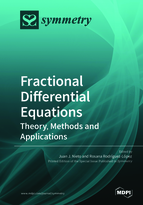Fractional Differential Equations: Theory, Methods and Applications
A special issue of Symmetry (ISSN 2073-8994). This special issue belongs to the section "Mathematics".
Deadline for manuscript submissions: closed (28 February 2019) | Viewed by 30626
Special Issue Editors
Interests: nonlinear differential equations; fractional models; biomedical applications; digital twins
Special Issues, Collections and Topics in MDPI journals
Interests: ordinary and functional differential equations; fractional differential equations; nonlinear analysis; fixed point theory; fuzzy mathematics
Special Issue Information
Dear Colleagues,
Fractional calculus provides the possibility of introducing integrals and derivatives of arbitrary order in the mathematical modelling of physical processes, and it has become a relevant subject with applications to various fields, such as anomalous diffusion, propagation in different media or in relation with materials with different properties. However, many aspects from the theoretical and practical point of view have still to be developed in relation with models based on fractional operators.
This Special Issue is related to the new developments on different aspects of fractional differential equations, both from the theoretical point of view and from the applications in different fields such as physics, chemistry, or control theory, for instance. The topics of the issue include: fractional calculus, the mathematical analysis of the properties of the solutions to fractional equations, the extension of classical approaches, or the applications of fractional equations to several fields, among others.
Prof. Dr. Juan J. Nieto
Prof. Rosana Rodríguez-López
Guest Editors
Manuscript Submission Information
Manuscripts should be submitted online at www.mdpi.com by registering and logging in to this website. Once you are registered, click here to go to the submission form. Manuscripts can be submitted until the deadline. All submissions that pass pre-check are peer-reviewed. Accepted papers will be published continuously in the journal (as soon as accepted) and will be listed together on the special issue website. Research articles, review articles as well as short communications are invited. For planned papers, a title and short abstract (about 100 words) can be sent to the Editorial Office for announcement on this website.
Submitted manuscripts should not have been published previously, nor be under consideration for publication elsewhere (except conference proceedings papers). All manuscripts are thoroughly refereed through a single-blind peer-review process. A guide for authors and other relevant information for submission of manuscripts is available on the Instructions for Authors page. Symmetry is an international peer-reviewed open access monthly journal published by MDPI.
Please visit the Instructions for Authors page before submitting a manuscript. The Article Processing Charge (APC) for publication in this open access journal is 2400 CHF (Swiss Francs). Submitted papers should be well formatted and use good English. Authors may use MDPI's English editing service prior to publication or during author revisions.
Keywords
- Fractional Calculus
- Equations with Fractional Operators
- Fractional Differential Equations
- Applications







